Yuichi Yonebayashi – Art and Space – 2004
With K.Katayama, S.Onobori, H.Sakaguchi, S.Kitago, M.Miyanaga, D.Sato, H.Hongo, et.al, Tokyo National Universiy of Fine Ats and Music
First publication workshop Space: Science, Technology and the Arts in collaboration with ESA/ESTEC, 2004
For three years, beginning in August of 2000, seventeen professors and our graduate students in nine departments of our University (Painting, Sculpture, Crafts, Design, Architecture, Art History, Art Education, Art Anatomy, and Multi-media) have studied and worked together to propose and in most cases conduct the following research projects.
Our aim has first been to somehow help contribute the perspective of artists to the Japanese Space Development program (formerly NASDA, now called JAXA), if we can. NASDA/JAXA has been busy planning the Japanese Experimental Module of the International Space Station, and has actively sought the advice of writers, artists, and others working in the field of humanites and the social sciences. Secondly, we wanted to convey to students and to young Japanese artists information about recent developments in space research (normally not a field they are aware of), to give them a new and deeper awareness of nature, of humanity, and of the world as a whole, and to stimulate their imagination.
The "MA" space project
Human beings have lived and have developed their histories in the gravitational context of the earth. In contrast, a space station imposes an environment of micro-gravity. There, humans must face the constraints of living within severely restricted confines while floating in limited space, while they are subjected to such anxieties as whether their position is up or down. Moreover, their activities are not allowed to transgress the extremely limited confines of the space station.
In this project we have been considering the Japanese concept of « MA », which literally means simply space or interval, but which deeply permeates Japanese thinking and feeling about many things, including physical space, human relations, time, and rhythm. We applied the concept of « MA » in particular to current astronauts and future long-term residents of space, in terms of their working space, living space, and areas of everyday activities. We addressed such issues as the habitation of structures with minimal support in a very limited space, life supporting activities performed while floating, the design of rooms and facilities that are suitable for such conditions, and a yearly cycle without seasons. All these conditions are quite different from those that exist naturally on earth. Our research considers the kinds of living and working spaces that might be promoted for people living long-term in the space station or elsewhere in space.
One of our proposals in particular has attracted quite a bit of interest. This is to build a small room in the space station which would function in a similar way to a traditional Japanese tea-ceremony room (which are often very small rooms, even on earth). Of course we couldn’t have real boiling water, tea, kimonos, and carefully arranged flowers and art objects, but we could design it as a room for meditation or prayer, for calming stress and tension, and for quiet communication without any sense of heirarchy among those using the room. Alternatively, we could make this space only large enough for one person at a time, but design it so that he or she can be in a fixed position, as a temporary relief to the stress of being always free-floating and weightless in near-zero gravity. We came up with several designs for this.
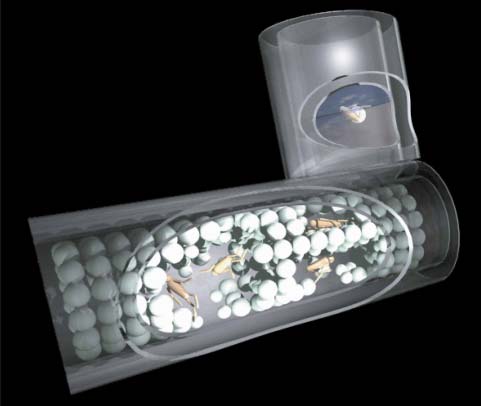
Spheres are natural shapes in micro-gravity.
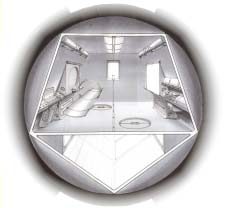
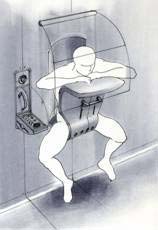
Another idea we had is to make a double-tube activity room, made with translucent, flexible membrane-like material which would increase the movement potential of astronauts in near-zero gravity (they can make their way along the walls of the tube) and also offer a sense of psychological calm and security similar to what a fetus would feel in its mother’s womb.
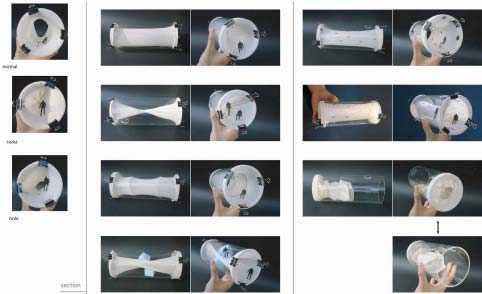
The borderless art project
In the past, only God could have had a bird’s eye view of the earth from outer space. Now humans can view the earth and the universe from space. How should we reconsider the meaning of the earth’s creation in the context of what we have hitherto believed? We are facing a new paradigm that hastens to change our conventional sense of values.
The arts have until now been expressed, produced and enjoyed within the framework of religion, race, culture, and history, all of which developed on earth. In contrast, in this project we studied the possibilities of artistic expression in space. We also attempted to create expressive images of the earth traveling in space, the universe as a whole, etc.
For example, one of our ideas was to produce a 3D object based on the actual orbit path of the space shuttle, on a scale of 1:1,000,000,000. With this object, which we can hold in our hand, we can be stimulated to form new ideas about our spaceship « Earth ». In the future, we hope to do experiments on the theme of art expression in the actual space environment by requesting that astronauts on board the space shuttle conduct art experiments while in orbit, while simultaneously we will conduct collaborative art experiments on earth. We have several such collaborative art projects planned, which we hope to implement.
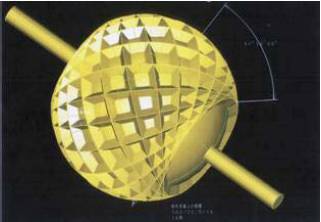
Fig. 5. Orbit path of the International Space Station (computer graphics)
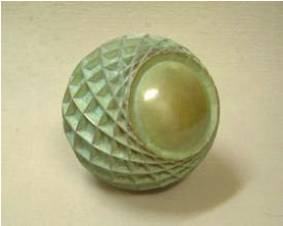
Fig. 6. Spherical model of the orbit path of the ISS (bronze)
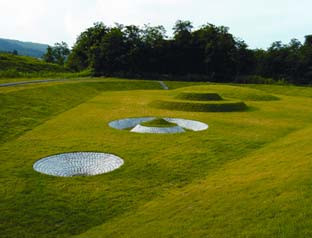
The Venus project
All of the flora and fauna of the earth have evolved in a gravitational environment. Flying birds, swimming fish, spreading branches and roots of plants, and our own human bodies: without exception all living things are products of the e been inspirational in generating endless varieties of artistic cre man beings usually remain unaware of gravity throughout their whole lives. However, once they go into space, weightlessness strongly reminds them of the force and effect of gravity on earth.
The inherent beauty of the human body and of the natural forms that exist on earth have been reproduced by artists whose sense of beauty has been influenced by a gravitational environment. For example, the beautiful proportion, sense of movement, and balance of the Venus de Milo has its meaning only within the context of gravity. In this project we have studied in particular the beauty of the human form from the standpoint of fine art and anatomy, via micro-gravity experiments and observations.
For example, we made a detailed wax model of the head of one of our graduate students, with earth’s gravity in full force, of course. Then we put her into parabolic flight (micro-gravity) and with a scanner took detailed digital images of her head, especially her face, while she was weightless. Based on these images we made another wax model, and compared the two. While weightless,her face became puffy, the so-called « moon face » which all astronauts experience. We wonder whether, in the future, not only our physical bodies but our aesthetic sense of beauty itself may change over time, influenced by the long-term effects of living in a micro-gravity environment.
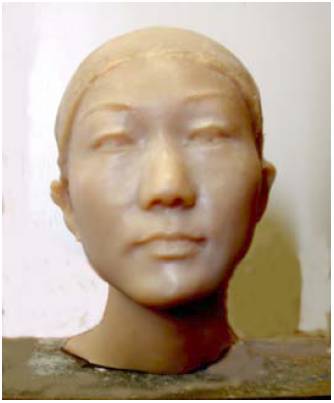
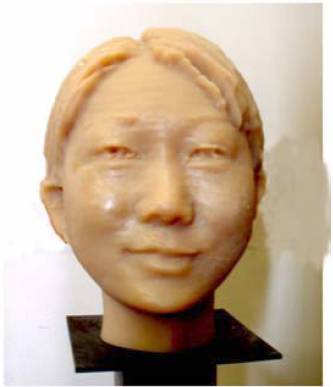
History of human perception of the universe
Human perception of the world, of nature, our religious beliefs, and so on, have all developed and changed over time in tight correlation to our changing perception of the universe and its celestial bodies. In both the East and the West, the universe used to have meanings other than merely the recognition of stars and planets, or as something to be subjected to scientific study. It led us to other worlds, such as life and death, God and humanity, future and past.
In this project, by carefully examining many art works -ancient and modern, Eastern and Western- we investigated how humans have formed and expressed their sense of the universe, how that sense of the universe differs from region to region and culture to culture, and how it has changed over time.
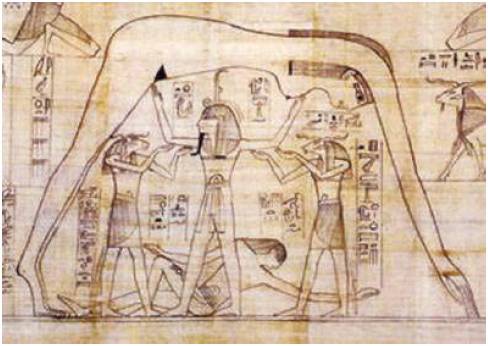
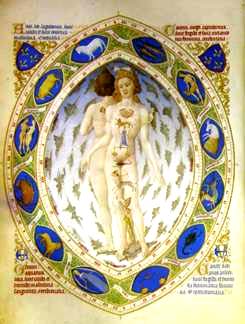
We researched similarities and differences in how the universe is depicted or implied in Persian gardens; Navajo sand art; the installations and landscape of James Turrell; ancient astrology and fotune-telling manuals (both Western and Eastern; Buddhist mandalas; Psychedelic Art and Op Art (optical illusions) from the 1960’s; Stonehenge; Zen art in many forms (including their calendars); old Norse mythology; Egyption art; the paintings of Tadao Yokoo (a contemporary Japanese artist); medieval European Books of Hours; and many others.
We then studied the development of overall cosmologies in the Orient (India, China, Korea and Japan), and those of Egypt, Mesopotamia, Persia, Greece, Rome, the medieval Christian world, the Renaissance, the shift from Ptolemaic to Copernican theories, the Enlightenment, etc., in the West. We also took interest in how humans at this current point in history -just as we are on the cusp of a new era of space research and space travel for humans- conceive the universe.
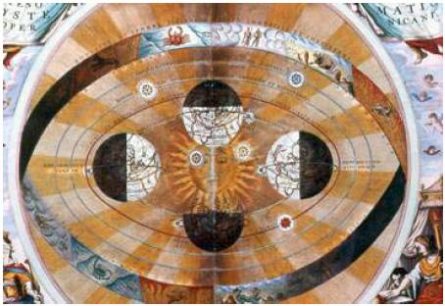
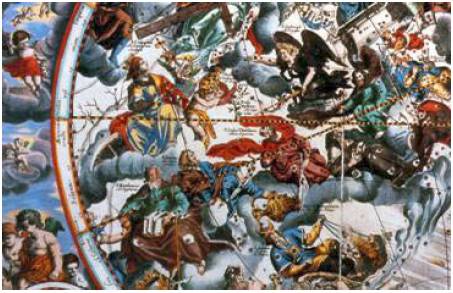
One interesting discovery was to see how very differently people from a monotheistic culture (in particular those who view their God as resembling humans, or rather humans as made in God’s image) perceive the universe and nature, from those wo believe in many gods which do not have human forms. The former tend to view nature as below them, as something to be subjected and used for their own benefit. They believe that their utmost duty in life is to understand God’s will and to obey it. Unsurprisingly, their cosmologies are straightforward: easy to understand, easy to explain to others. The polytheists, on the other hand, especially those who believe in gods that do not resemble humans, have cosmologies that are exceedingly complex and esoteric: difficult to understand and difficult to explain to others. Their sense of who they are as humans is also affected: they see themselves as simply part of nature, without any special rights or privileges that set them above nature.
We suspect that the strong aversion Western people seem to have toward robtos that appear human, in contrast to Japan, for example, where such robots are popular, and are seen as toys or pets, or as our future friends, has something to do with these same cultural roots. The ISS (International Space Station) now under construction is not humanoid in shape, but we think that eventually with all of its varied modules or booths from different countries connected as though in a polytheistic cosmos, it will begin to seem like a futuristic cultural cooperative system.
Exhibition and symposium
We had hoped to hold an exhibition showing the frutis of this three-year joint research effort, at the art museum affiliated with our university, but in the end were unable to do so, due to insufficient time to secure the necessary financing, adn to the fact that we felt our reserach was still in its early stage.
However, we did organize a six-hour symposium last October entitled « Art in Space », which presented the four major projects I just introduced to you, and also included a talk by Chiaki Mukai, as well as a panel discussion. The venue was a large hall at our university, where me maintain a collection of plaster casts of many sculpture masterpieces from both Europe and Asia -a surreal and yet somehow appropriate setting. The symposium was well attended by students and the general public, and generated much interest. We distributed a 130-page report on our joint reserach activities, to all those who attended.
Mrs Mulai is perhaps Japan’s best-known astronaut, who has worked many years at NASA and has been on many of the NASA-organized space missions. Her talk was exceptionally interesting, and we all came away with a better grasp and deeper awareness of the universe than we had before. For all of us, the symposium and the research it was based on strongly reinforced our belief that we must maintain this vital dialogue between artists and scientists, especially those scientists who are working on space exploration and research.
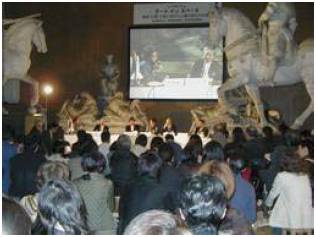
© Yuichi YONEBAYASHI & Leonardo/Olats, mai 2004, republished 2023
Leonardo/Olats
Observatoire Leonardo des Arts et des Techno-Sciences
À propos / About | Lettre d'information Olats News



Pour toute (re)publication, merci de contacter / For any (re)publication, please contact Annick Bureaud: info@olats.org
Pour toute question concernant le site, merci de contacter / For any issue about the website, please contact: webmaster@olats.org
Design Thierry Fournier
© Association Leonardo 1997-2022